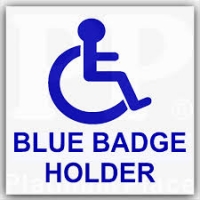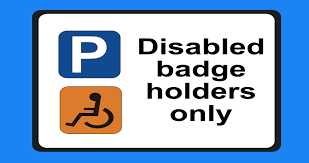The Blue Badge Scheme - How it Works
Tuesday 26 November, 2019 Written by Caitlin Purvis/Simon Collyer
DISABILITY - Parking is a hot issue at the moment and is likely to get worse with private parking companies making fortunes out of motorists and local councils funding their operations via parking fines. In the US virtually whole towns budgets are being funded by traffic citations. In the US it is called 'Policing for Profit'.
We must thank Caitlin Purvis for supplying this very useful information about the Blue Badge scheme.
Rights as a blue badge holder – what are you entitled to?
If you have a Blue Badge, you will open up a range of opportunities. The badge may be issued automatically if you receive a mobility allowance. One example of this is that it allows you to park closer to a destination, whether you’re a passenger or the driver, and is usually issued by your local council for three years and costs £10.
However, if you have an allowance which ends before the three-year period ends, your Blue Badge will coincide with this. Alongside Blue Badges, mobility allowance can also be a good way to find yourself perfect Motability deals.
If you are the owner of a Blue Badge, you have many rights and responsibilities you should be aware of. Here, alongside used car dealers Lookers, we take a look at the necessary information to ensure you’re in the know.
How can you apply for a Blue Badge?
You must have your National Insurance number readily available if you are applying for your badge, or a child reference number if the application is for a minor. If you already have a driving licence, you’ll be required to provide your details alongside the number, local council and expiry date on your current Blue Badge — if you own one.
Also required is proof of identification, a photo which is up to date, proof of address and, if you’re automatically eligible, your original decision letter from the Department of Work and Pensions (DWP) will need to be provided. You’ll be required to fill in an additional section on the form if you’re not automatically eligible. You should hear back from your council within six to eight weeks and you may be asked to do a mobility assessment or to send extra information before you are granted with the badge. If for whatever reason you are refused, you can ask for the decision to be reconsidered. To apply when you’re automatically eligible is straightforward and you can fill in the form online, or by contacting your local council.

Which requirements must you meet to qualify for a Blue Badge?
- The applicant must be over two years old to qualify. There are five reasons you will automatically qualify:
- You get a Personal Independence Payment which shows an eligible descriptor of the ‘moving around’ activity of the mobility component
- You receive a War Pensioner’s Mobility supplement
- You receive a higher rate of the mobility component of Disability Living Allowance (DLA)
- You are registered blind
- You have been given a sum by the Armed Forces and Reserve Forces Compensation Scheme and have been registered with a substantial and permanent disability
- However other reasons you may be entitled to own a Blue Badge include if you:
- Have a substantial or permanent disability that means you can’t, or it’s very difficult to walk
- Have a terminal illness which interferes with your ability to walk and has led to you being issued with a DS1500
- Regularly drive a vehicle and have severe disabilities with your arms
Can you use your blue badge abroad?
Your Blue Badge is also recognised throughout the European Union (EU). However, it must be noted that the concessions provided may not be the same as those in the UK. This highlights that currently, there are no arrangements in place that would allow you to use your badge outside the EU in countries such as Australia, New Zealand, USA and Canada.
Is there particularly areas which it can’t be used?
- You must always display your blue parking clock in sight for wardens to see your arrival time. Unlike other drivers, holding a Blue Badge allows you to park on single or double yellow lines for up to three hours as long as you’re not blocking any loading or unloading areas.
- Make sure you know what any off-street car park establishments’ status is. You should never assume you can just park for free or you may receive a nasty surprise.
- You must also remember that just because you own a Blue Badge, you don’t have free reign on where you can park. Also, if you’re not the driver, you must make sure whoever is behind the wheel also knows this. It is only intended for on-street parking, with off-street car parks such as supermarkets spaces being governed by separate rules. You must make sure you do not park anywhere which could cause an obstruction or be a danger to other road users. Doing so may result in a Penalty Charge Notice being handed out, or worse yet your vehicle may be removed.
- If you’re not in England, but still in the UK, check what that country’s concessions are with the relevant authority. The same goes for travelling in London — check with Transport for London for further information. This is due to the fact the scheme doesn’t fully apply in the City of London, the Royal Borough of Kensington and Chelsea and part of the London Borough of Camden.
- If you’re parking in a zone which is covered by parking meters and pay-and-display machines, you can park free of charge for as long as is required if you display your badge. This also goes for disabled parking bays, unless it states otherwise.
Can someone use a blue badge on your behalf?
If you’re a passenger or the driver, then your badge is okay to use. However, misuse is illegal. If the badge is used without you in attendance, the user could be fined up to £1,000 and the badge may be confiscated. If you are a passenger, it’s your responsibility to make sure that the driver is aware of any rules laid out.
Don’t ever allow your family or friends to use the badge to gain free parking – even if they are using it to visit you. Also, although it’s not illegal to do so, you shouldn’t sit in the car while someone else takes advantage of the badge’s benefits.
Is there a correct way to display your blue badge?
Don’t have your photograph on show, but do make sure your details remain legible. The best way to do this is by placing it on the dashboard or facia panel so that it can be read through your front windscreen. It’s your responsibility to make sure the badge is visible to any traffic warden that may pass your vehicle.
So, it’s clear that the Blue Badge is a top tool to help those who need it continue your everyday life. However, be sure to take note of where you can and can’t use it to make sure you aren’t stung be any unwanted fines!
Sources
https://my.northtyneside.gov.uk/category/727/using-your-blue-badge

ABC Comment, have your say below:

Leave a comment
Make sure you enter all the required information, indicated by an asterisk (*). HTML code is not allowed.
Join
FREE
Here










